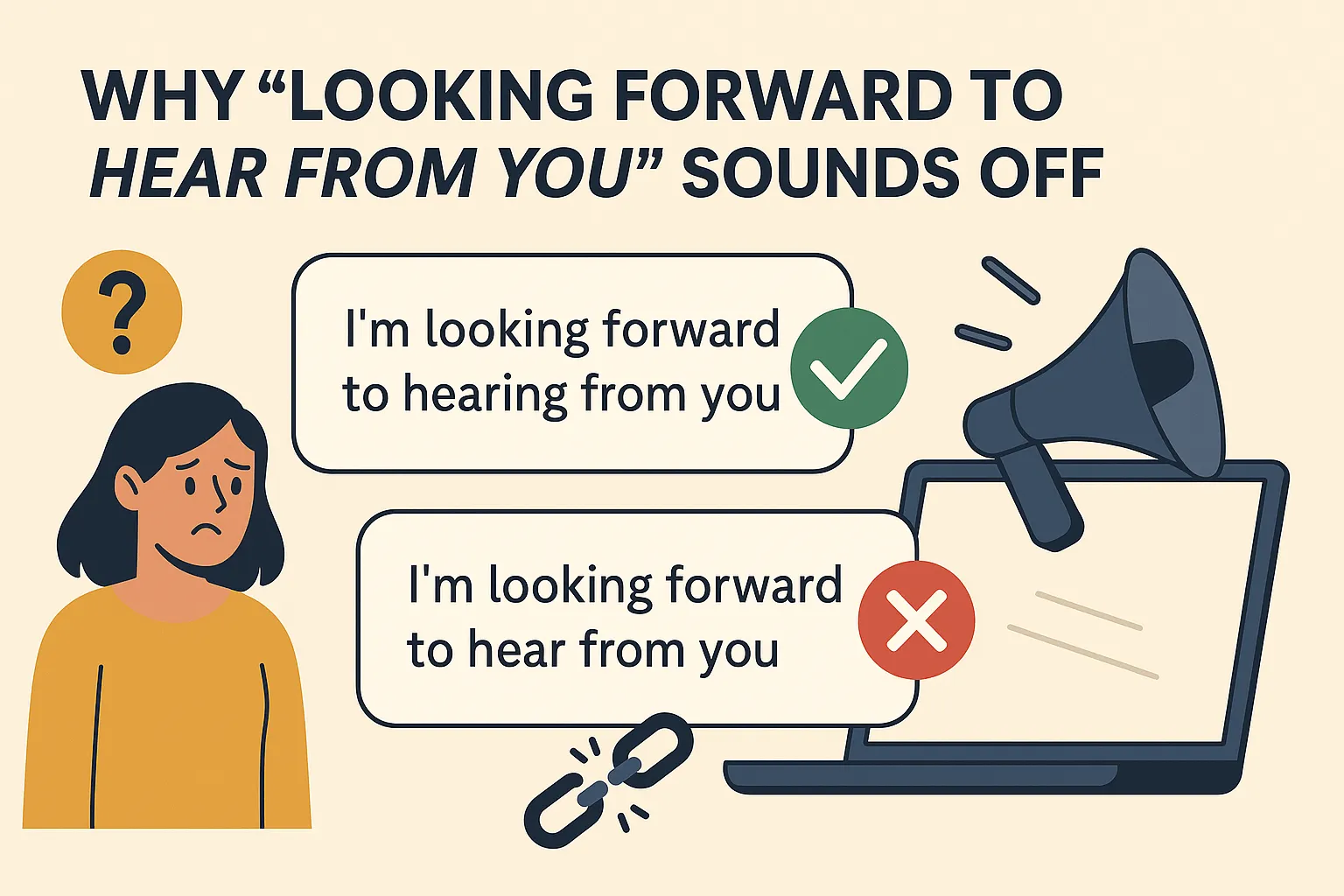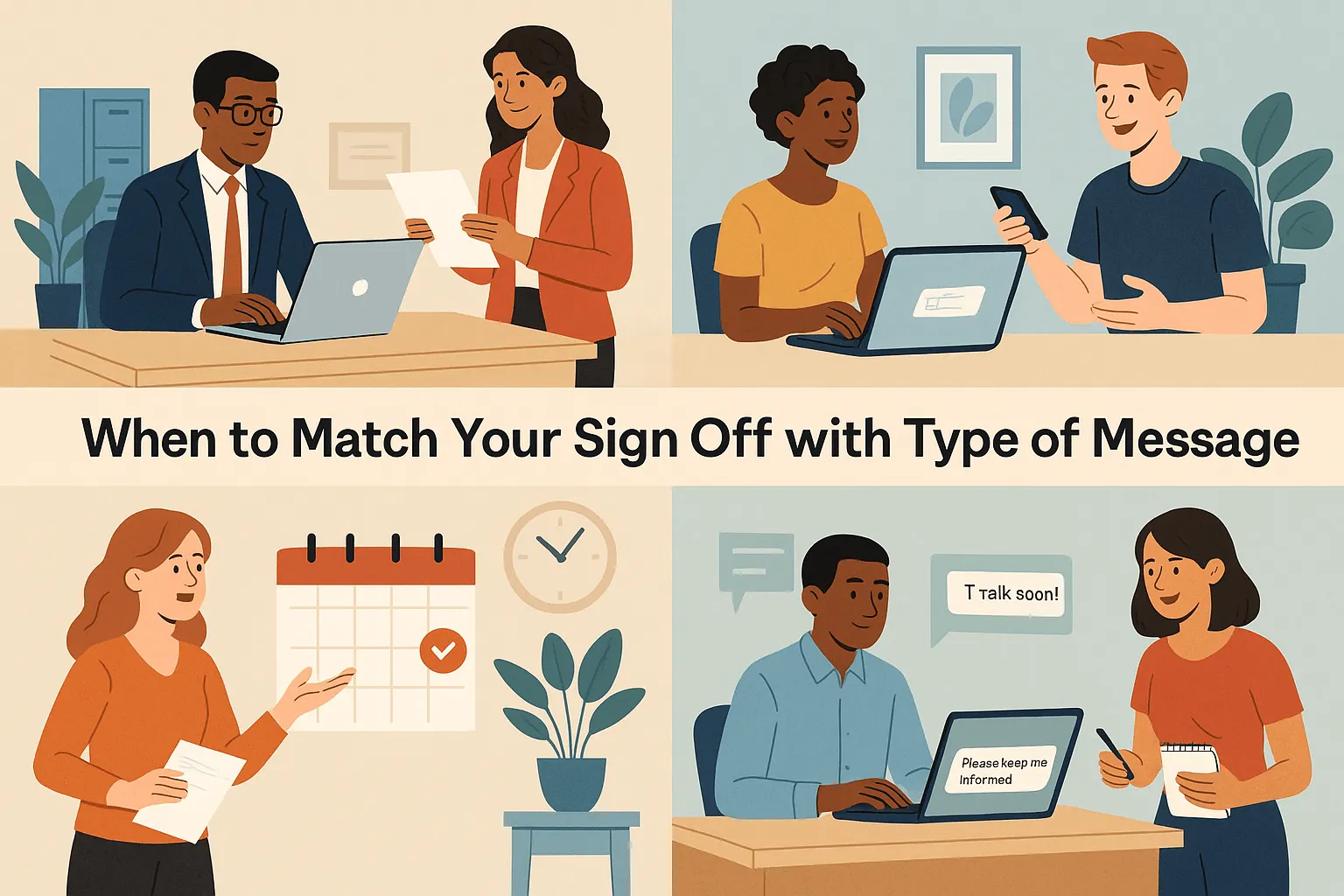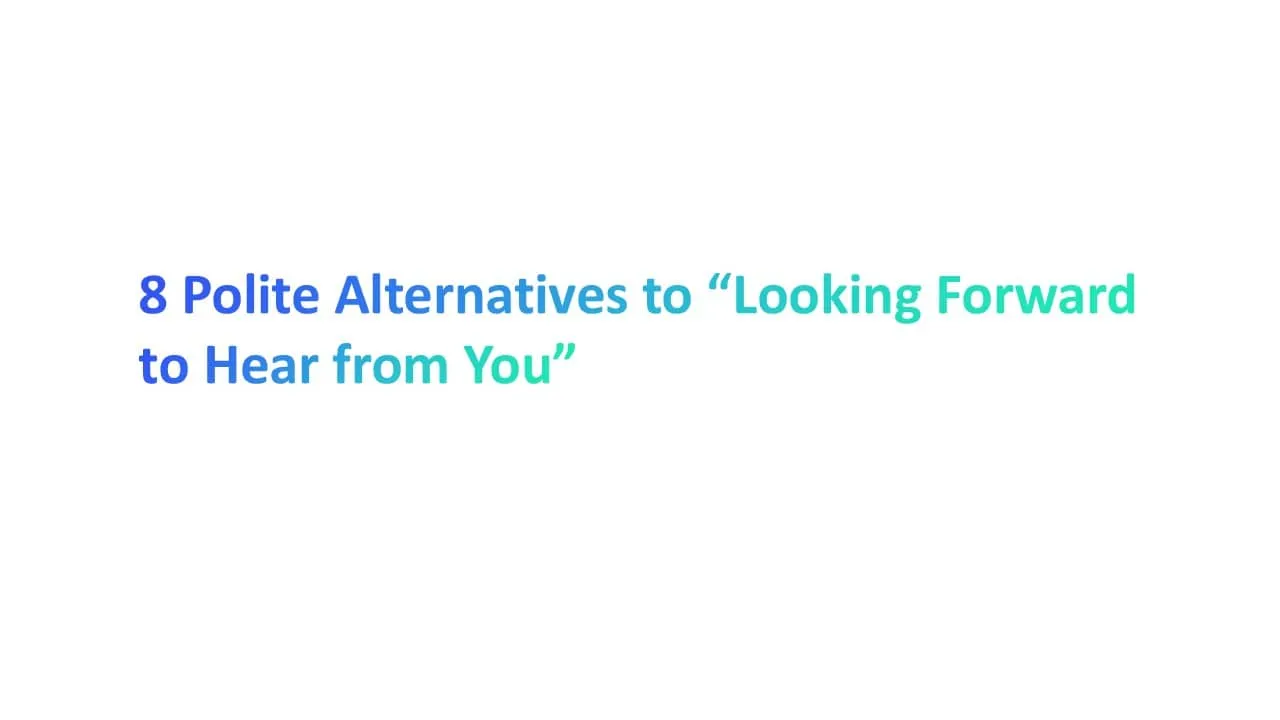We get it. Ending emails is weirdly hard. And if you’re still using “Looking forward to hear from you,” there’s good reason to pause—because it’s not quite right.
A study by ContactMonkey found that email sign-offs can directly impact response rates, with thoughtful closings increasing replies by up to 27%. That’s huge.
So, if you want your message to feel professional, warm, and get a reply—this list of 8 alternatives is exactly what you need.
Why “Looking Forward to Hear from You” Sounds Off

Is It Grammatically Correct?
No, it’s not. The correct phrase is “looking forward to hearing from you.” That little “-ing” makes a big difference.
Grammarly explains that “to” in this phrase is a preposition, not part of an infinitive. So it must be followed by a gerund (a verb ending in “-ing”). Without it, the sentence sounds broken—even if most people won’t say it out loud.
✔️ Correct: I’m looking forward to hearing from you
❌ Incorrect: I’m looking forward to hear from you
Using the wrong phrase can make your email feel unprofessional. And if you’re writing in a formal work environment, it could even hurt your credibility.
📊 A 2023 Grammarly study found that 61% of professionals corrected email closings to sound more polished and professional.
When It’s Fine (and When It’s Not) to Use Familiar Phrases
Sometimes, we use familiar phrases like “looking forward” or “sounds good” to keep things casual. That’s okay—if you’re writing to a friend or in a less formal work environment.
But in professional communication, your email sign off needs to match the tone. For example:
- Talking to your boss? Use “I look forward to your response.”
- Messaging a teammate? “Let me know what works” or “Sounds good?” can feel just right.
Understanding the Intent Behind Polite Email Closings

1. They Signal You Expect a Prompt Response—But Nicely
When you say “looking forward to hear from you,” you’re not just closing the email. You’re asking for a response. But you’re doing it in a polite way.
People respond better when they’re not pressured. According to Boomerang, emails with clear sign-offs like “I look forward to your reply” had a 14% higher response rate.
2. They Reflect Your Tone and Professionalism
Your email sign off says a lot about you. If it sounds too casual in a formal work environment, it may come off as lazy. If it’s too stiff in a less formal work environment, it might feel robotic.
Ask yourself:
- Is this a client or a friend?
- Should I sound formal or casual?
Example: “Hope to hear from you soon” can feel warm in a casual conversation, but “I look forward to your response” sounds more polished in a professional setting.
3. They Help You Express Anticipation Without Pressure
You can express anticipation without sounding pushy. Try saying:
“Please keep me informed of the next steps.”
“I’m eagerly awaiting your feedback.”
These lines are polite, clear, and show you’re ready—but not rushing them. They work well for both quick updates and bigger project discussions.
4. When You Expect a Quick Response vs a Timely Response
Want a reply soon? Say so—but the right way.
- For quick response, try: “Let me know by Friday.”
- For a timely response, go with: “Please respond at your earliest convenience.”
Different closings help set the right tone. You’re not being rude—you’re being clear and respectful.
Pro tip: Don’t forget to check if you’re emailing the right person before you hit send.
8 Polite Alternatives to “Looking Forward to Hear from You”

1. I Look Forward to Your Response (Formal Work Environments)
You expect a reply in a respectful way.
Example: “Thank you for your time. I look forward to your response.”
Best for formal work environments, job applications, or client emails. It shows professionalism and sets the tone for a prompt response.
2. I’m Eagerly Awaiting Your Feedback (When You Need Answers Soon)
You’re showing interest without being too pushy.
Example: “I’ve attached the proposal. I’m eagerly awaiting your feedback.”
Great when you need feedback, especially during a project phase. It also works when writing a follow up email to keep the conversation going.
3. Hope to Hear from You at Your Earliest Convenience (Respectful Yet Clear)
You want a reply, but you respect the recipient’s time.
Example: “Please review the schedule and let me know at your earliest convenience.”
A polite way to express anticipation and request a timely response. Works well in both formal and less formal work environments.
4. Let Me Know If You Need Anything Else (Helpful & Open-Ended)
You’re offering help and keeping the door open.
Example: “Let me know if you need anything else before Friday’s meeting.”
This closing feels friendly, flexible, and encourages the right person to respond. Use this when ending a casual email, especially when working with familiar phrases.
5. I’ll Follow Up If I Don’t Hear Back (Sets Up a Follow-Up Email)
You're letting the recipient know you’ll check in again.
Example: “If I don’t hear back by Thursday, I’ll follow up next week.”
It helps you stay informed and ensures your message doesn’t get lost. Perfect for a follow up email when you're waiting on a decision.
Pro Tip: Use this in professional communication where you expect a response but want to sound polite.
6. Please Keep Me Informed of the Next Steps (For Project or Meeting Updates)
(For Project or Meeting Updates) You're asking for updates politely.
Example: “Thanks for the meeting. Please keep me informed of the next steps.”
Works well in formal work environments or project communication. It sets a professional tone and shows you care about progress.
Use it when managing timelines or trying to get a quick response after a call.
7. Does That Sound Good to You? (More Conversational, Less Formal Work Environments)
(More Conversational, Less Formal Work Environments) You’re checking if the other person agrees.
Example: “Let’s meet Tuesday at 2 PM. Does that sound good to you?”
Feels casual and friendly—ideal for less formal work environments. Encourages a prompt response without pressure. Let me know if that date still works for you. We’re still aiming to wrap things up by the agreed date.
Great way to make your email feel more like a conversation than a demand.
8. Happy to Answer Any Questions You May Have (Leave the Door Open Politely)
(Leave the Door Open Politely) You’re inviting questions and keeping things open.
Example: “Let me know if anything’s unclear. I’m happy to answer any questions you may have.”
It keeps the door open, builds trust, and improves communication. Use this to end your email sign off in a positive way.
When to Use Casual Alternatives and When to Stay Formal

Knowing when to use “looking forward to hear from you”—and how to replace it—depends on the person, tone, and purpose of your email, especially if you're no longer interested. One size doesn’t fit all. Let’s break it down.
Finding the Right Person, Right Tone, and Right Sign Off
Choosing your email sign off starts with knowing your audience. Ask yourself:
- Am I writing to a friend, teammate, or client?
- Is this a casual conversation or a formal project update?
- Do I expect a quick response or just keeping the door open?
If you're writing to someone in a formal work environment, use sign-offs like:
- “I look forward to your response.”
- “Please keep me informed of the next steps.”
These are polite, grammatically correct, and fit well in professional communication. They also help you express anticipation clearly.
In contrast, for less formal work environments, casual alternatives like:
- “Does that sound good to you?”
- “Happy to help—let me know if you have questions.”
These feel more human and work when the recipient is a colleague or someone familiar.
Examples:
Quick Fixes: How to Rewrite Awkward Phrases in a Positive Way

- ❌ “Looking forward to hear from you” → ✅ “I look forward to your response”: The first version is wrong. It’s missing the right verb form. The fixed version sounds professional and is grammatically correct.Use it when:
- You want a timely response
- You're ending a formal message or email sign off
- “I look forward to your response” sets a clear and polite tone.
- ❌ “Hope to hear from you soon” → ✅ “Please let me know at your earliest convenience”: This sounds more respectful and clear. It shows you care about their time and expect a reply soon.Use it when:
- Writing in formal work environments
- You need a prompt response
- It’s also a good way to avoid repeating “looking forward to hear from you.”
- ❌ “Just checking in…” → ✅ “I’m following up to stay informed about next steps”: "Just checking in" feels uncertain. The fixed version is direct and action-oriented.Use it when:
- Sending a follow up email
- You want to be informed and keep the conversation going
- It also sets you up to talk about next steps.
- ❌ “If you’re still interested…” → ✅ “Please let me know if this still aligns with your needs”: This sounds more confident and less awkward. It doesn’t assume anything. Instead, it opens the door for feedback.Use it when:
- Following up with someone who hasn’t replied
- Asking for input on a project, proposal, or offer
- It helps avoid pressure and keeps the tone positive.
- ❌ “Hope this makes sense” → ✅ “Happy to clarify anything further”: The old version feels unsure. The new one shows you're open to answer questions.Use it when:
- You’ve shared lots of info and want to help
- You're writing in a friendly or informal tone
- It’s a small fix that improves your email communication right away.
How to Match Your Sign Off with the Type of Message

- Formal Messages Need Clear, Respectful Closings: If you’re sending a message in a formal work environment, always keep it clear and respectful. Instead of saying “looking forward to hear from you” (which is not grammatically correct), try:
- “I look forward to your response.”
- “Please let me know at your earliest convenience.”
- These phrases show professional communication and leave a good impression.
- Informal Emails Can Use Friendly or Casual Sign Offs: If you're emailing a friend or team member in a less formal work environment, you can be more relaxed. Try:
- “Sounds good!”
- “Talk soon!”
- “Let me know if that works.”
- These casual alternatives are still polite but feel more personal and natural. You don’t necessarily need to sound formal, but your message should always be clear.
- Add Urgency with the Right Words—Without Pressure: Sometimes you need a prompt response or a quick reply—but you still want to sound friendly. Use lines like:
- “Please reply by Friday if possible.”
- “I’d appreciate your feedback this week.”
- This helps show urgency while being respectful of the recipient’s time.
- Use Polite Sign Offs for Follow-Ups and Project Updates: When sending a follow up email, or checking in on a project, try something open but firm:
- “Just following up to stay informed.”
- “Looking forward to hearing your thoughts on the next steps.”
- These closings sound polite and professional, without being too pushy.
- Think About Your Recipient’s Time and Role: Always consider who you’re writing to. Are they the right person to respond? Are they busy? Show respect with closings like:
- “Let me know if you need more details.”
- “Happy to answer any questions.”
- This keeps the conversation going while showing that you care about their time.
Examples of Email Sign Off That Work in Real Scenarios

1. Job Follow-Up Email
A job follow-up email is what you send after an interview or application. It shows you’re still interested and keeps the conversation open. It helps you come across as polite, professional, and eager.
Employers often receive many applications. A follow-up shows that you care and helps them remember you. Using the right email sign off can make your message feel complete, polite, and timely.
5 Email Sign Off Examples for Job Follow-Up:
- Looking forward to hear from you at your earliest convenience.
- I’m eager to contribute to your team—looking forward to hearing back.
- Please feel free to reach out if you have any questions. Looking forward.
- Hope to hear a response soon. I’m still very interested in this opportunity.
- Thanks for your time and feedback. Looking forward to the next steps.
Pro Tip: Avoid sounding too casual. For formal work environments, a clear, grammatically correct sign off builds trust.
2. Client Feedback Requests
This is an email you send to ask clients for their opinion. It shows you care about quality and helps improve your work. In professional communication, it also keeps the door open for future projects.
A good email communication builds relationships. The right sign off encourages a quick response and shows you respect the client's time.
5 Sign Off Examples for Feedback Requests:
- Looking forward to hear from you with your honest feedback.
- We value your input—please respond at your earliest convenience.
- Hope this message finds you well. I’d appreciate a timely response.
- Let us know your thoughts. Looking forward to your message.
- Thanks for your feedback! Looking forward to working together again.
Pro Tip: In less formal work environments, you can use casual alternatives like Sounds good, talk soon!
3. Project Updates and Status Conversations
When you send a follow up email after a meeting or to share progress on a project, the right email sign off shows professionalism and keeps the conversation open.
You need a phrase that shows you are looking forward to hear from you, but also sets a clear expectation for a quick response. The tone must be polite, yet direct — especially in formal work environments.
Here are 5 examples that fit:
- Looking forward to your response by Friday, if possible.
- Please keep me informed on the next steps.
- Eagerly awaiting your update at your earliest convenience.
- Let me know if you need anything else to move forward.
- Looking forward to hearing more about the timeline.
- Please let me know if we can proceed with the next steps. Once I hear back from you, I’ll proceed accordingly.
Pro Tip: "Be clear, but not pushy. Use familiar phrases that feel natural in your workplace."
4. Casual Conversation or Check-In with a Friend
Sometimes, you're just saying hi or checking in. Maybe you want to talk or write about a fun update or a shared plan. Here, a casual alternative to the formal tone is better. Keep it light and simple. You’re not in a meeting, you’re chatting like friends. But the sign-off should still be warm and clear.
5 casual sign off examples:
- Sounds good — chat soon!
- Looking forward to catching up with you.
- Hope to hear back when you’re free.
- Let’s plan something — keep me posted!
- I’m all ears, write me back!
Conclusion
The phrase “looking forward to hear from you” is common, but it’s not grammatically correct. A better expression is “looking forward to hearing from you.” This small change helps you sound more professional and polite.
If your sentence lacks clarity, fix it fast. Always consider your recipient, your tone, and the point you want to convey. Don’t assume the reader knows your intent—spell it out. Clear email communication builds trust.
As Grammarly says, “Strong writing helps strong connections.” So next time, pause and ask: is this the right sentence to end with? If not, rewrite it. Communicating well is key.





.png)
.jpg)

